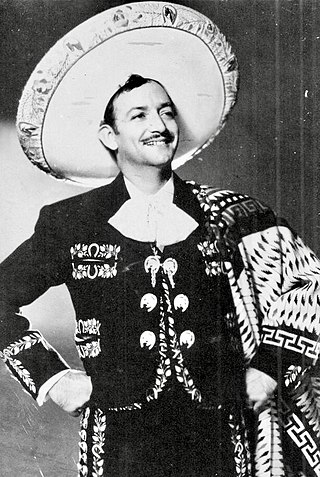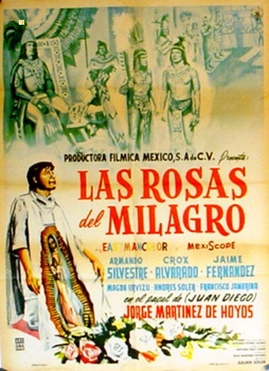
Jorge Alberto Negrete Moreno was a Mexican singer and actor.
The Golden Age of Mexican Cinema is a boom period in the history of Mexican cinema, which began in 1932 and culminated in 1969. It was characterized by the production of high-quality films that contributed to shaping Mexican national identity and culture. Films such as Luis Buñuel's "Los Olvidados" illuminated the social realities of Mexico, leaving a profound impact on audiences both within the country and abroad.

Jalisco Sings in Seville is a 1949 Mexican-Spanish musical comedy film directed by Fernando de Fuentes and starring Jorge Negrete, Carmen Sevilla and Jesús Tordesillas. This film represents the first Mexican-Spanish cinematic co-production. The story and musical numbers emphasize the cultural affinities between Mexico and Spain while warmly celebrating their differences. It was shot at the Chamartín Studios in Madrid and on location in Seville. The film's sets were designed by the art director Sigfrido Burmann.
The Golden Ariel is an award that “symbolizes the work of excellence that a member of the film industry has achieved throughout their career and that has contributed to the development and growth of Mexican cinematography”. The Golden Ariel is the highest award given to an individual or institution in the Mexican film industry by the Mexican Academy of Cinematographic Arts and Sciences. It has been awarded annually since 1946 as part of the Ariel Awards and is also given to films that win Best Picture. As of 2020 ceremony, the current recipients are composer Lucía Álvarez and actress María Rojo.

Land of Passions is a 1943 Mexican musical adventure film directed by José Benavides and starring Jorge Negrete, Margarita Mora and Pedro Armendáriz. It was shot at the Clasa Studios in Mexico City. The film's sets were designed by the art director Manuel Fontanals.

The Golden Boat is a 1947 Mexican musical comedy drama film directed by Joaquín Pardavé and starring Sofía Álvarez, Pedro Infante and Carlos Orellana. It was shot at the Azteca Studios in Mexico City. The film's sets were designed by the art director Edward Fitzgerald. It was in the tradition of Ranchera films, popular during the Golden Age of Mexican Cinema.

Lilia Michel was a Mexican television and film actress most active during the Golden Age of Mexican cinema, earning her the nickname of "the jewel" of the film era.

While Mexico Sleeps is a 1938 Mexican crime film directed by Alejandro Galindo and starring Arturo de Córdova, Gloria Morel and Miguel Arenas. The film's sets were designed by the art director Jorge Fernandez.

Sacrificed Women is a 1952 Mexican drama film directed by Alberto Gout and starring Ninón Sevilla, Roberto Cañedo and Víctor Junco. It was shot at the Churubusco Studios in Mexico City. The film's sets were designed by the art director Manuel Fontanals. Some scenes were shot in Eastmancolor.
Love for Love is a 1950 Mexican drama film directed by Ernesto Cortázar and starring Marga López, Antonio Badú and Víctor Junco.

The Miracle Roses is a 1960 Mexican historical drama film directed by Julián Soler and starring Armando Silvestre, Crox Alvarado, and Jaime Fernández. It is set around the time of the Spanish conquest of the Aztec Empire.

There Once Was a Husband is a 1953 Mexican musical comedy film directed by Fernando Méndez and starring Lilia Michel, Rafael Baledón and Pedro Infante. it was shot at the Churubusco Studios in Mexico City. The film's sets were designed by the art director Jorge Fernández.
El charro del misterio is a 1980 Mexican drama mystery action musical film directed by José Juan Munguía and starring José Martín, Alicia Juárez, Julio Aldama, Alfredo Gutiérrez, Beatriz Adriana and Alfonso Munguía. It is based on a story by Julio Tena.
¡Ay, Jalisco, no te rajes! is a 1941 Mexican film directed by Joselito Rodríguez, starring Jorge Negrete, Gloria Marín and Carlos López. It is the prequel to El Ametralladora, starring Pedro Infante in the role as Salvador Pérez Gómez 'El Ametralladora'. It is based on the book ¡Ay, Jalisco, no te rajes! by Aurelio Robles Castillo. Evita Muñoz was five years old when she played the character Chachita in the film, and also earning her the nickname she was known by for the length of her career. It was released at the Cine Olimpia on November 12, 1941.
Dos hijos desobedientes is a 1960 Mexican Western musical comedy film directed by Jaime Salvador and starring Pedro Armendáriz, Antonio Aguilar, Elvira Quintana and María Duval.

Marked Cards is a 1948 Mexican romantic comedy film directed by René Cardona and starring Pedro Infante, Marga López and Cardona. The plot is loosely inspired by William Shakespeare's The Taming of the Shrew. It was shot at the Azteca Studios in Mexico City. The film's sets were designed by the art director Luis Moya.

I Am a Charro of Rancho Grande is a 1947 Mexican musical comedy drama film directed by Joaquín Pardavé and starring Sofía Álvarez, Pedro Infante and René Cardona. It was shot at the Azteca Studios in Mexico City. The film's sets were designed by the art director Edward Fitzgerald. It was in the tradition of Ranchera films, popular during the Golden Age of Mexican Cinema.

The League of Songs is a 1941 Mexican musical comedy film directed by Chano Urueta and starring Ramón Armengod, Mapy Cortés and Domingo Soler. It was shot at the Azteca Studios in Mexico City. The film's sets were designed by the art director José Rodríguez Granada. It was part of the tradition of Ranchera films, popular during the Golden Age of Mexican Cinema.

If I'm to Be Killed Tomorrow is a 1947 Mexican comedy film directed by Miguel Zacarías and starring Sofía Álvarez, Pedro Infante and René Cardona. It was shot at the Churubusco Studios in Mexico City. The film's sets were designed by the art director Vicente Petit. A Ranchera film, it was produced during the Golden Age of Mexican Cinema. The title comes from a shortening of the expression "If I'm to be killed tomorrow, better to get it over with today".
Armando Soto La Marina (1909–1983) was a Mexican film actor. He appeared in a large number of productions from the Golden Age of Mexican Cinema onwards. He was considered a rising star in the 1940s but his erratic alcohol-fuelled behaviour led to him being relegated to smaller, supporting roles.













